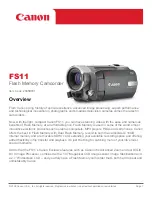
Chapter 2
Using the Profile Configuration Manager
56
Profile PRO Series
-
Pass
indicates that the vertical video line is passed-through.
-
Blank
indicated that line the group are blank.
5. Under Noise Reduction (earlier analog composite cards only), the controls
enable and set various noise reduction methods:
- Click
Enable Luma and Chroma Reduction
. This applies the Level and
Threshold settings to use a feedback noise reduction scheme on the
decoded input signals after they have been separated into chrominance
and luminance. The Level and Threshold sliders determine the amount of
weight the feedback signal has in comparison to the input signal. The
Threshold range takes into consideration the amount of motion in the
picture. Use the sliders to adjust the ranges. Be sure Enable Luma and
Chroma Reduction is checked for the reduction values to be applied.
- Click
Enable Quiet Line
, if desired. This acts as a noise reference. If the
Quiet line is noise-free, the rest of the signal should also be noise-free.
This allows the decoder to not mistake noise for motion. If the Quiet Line
is enabled, the line values for Field 1 and Field 2 are used. Use the sliders
to set the line values for each field. Click on
Default Lines
to return to the
default values.
-
Enable Impulse Noise Reduction
automatically filters out noise spikes,
such as amplifier crackling.
NOTE: If reduction of impulse noise is selected, the disk recorder
automatically switches the clamp speed to slow. It is recommended
that you use the spatial adaptive decode option, although it does not
automatically switch.
6. Click
Undo
to return the values in the dialog box to their original settings.
7. Click
Close
to accept all inputs.
Summary of Contents for Profile Pro II
Page 18: ...Preface 18 Profile PRO Series...
Page 34: ...Chapter 1 Introducing the Profile PRO Series 34 Profile PRO Series...
Page 96: ...Chapter 2 Using the Profile Configuration Manager 96 Profile PRO Series...
Page 115: ...Emptying the Recycle Bin Profile PRO Series 115 Figure 48 Recycle Bin properties dialog box...
Page 119: ...Viewing Properties Profile PRO Series 119 Figure 51 The transcode history page...
Page 158: ...Chapter 4 Using VdrPanel 158 Profile PRO Series Figure 76 Profile Options dialog box...
Page 183: ...Defining a New Clip Profile PRO Series 183 Figure 87 New Clip dialog box...
Page 202: ...Chapter 5 Using the Profile Disk Utility 202 Profile PRO Series...
Page 266: ...Chapter 8 Using the List Manager 266 Profile PRO Series Figure 131 A basic playback list...
Page 299: ...Configuring Video Resources Profile PRO Series 299 Figure 148 MPEG video track settings...
Page 302: ...Chapter 9 Using the Resource Manager 302 Profile PRO Series Figure 151 JPEG codec check boxes...
Page 311: ...Configuring Timecode Resources Profile PRO Series 311 Figure 158 Timecode Codec check boxes...
Page 316: ...Chapter 9 Using the Resource Manager 316 Profile PRO Series...
Page 342: ...Chapter 10 Using TimeDelay 342 Profile PRO Series...
Page 358: ...Glossary 358 Profile PRO Series...
Page 370: ...Index 370 Profile PRO Series...
















































